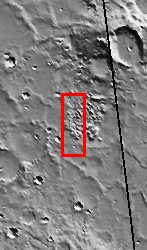
Released 4 August 2003
At first glance, this THEMIS visible image appears to show chaotic terrain similar to several other areas which have been shown on this web page in recent weeks. However, this knobby terrain is in the southern highlands and nearly 100 degrees of longitude away from the equatorial chaotic terrain related to the giant outflow channels in the northern hemisphere. In addition, this knobby terrain does not seem to be inside of any kind of basin, like much of the chaotic terrain. What we may be seeing here are remnants of a rock layer that once existed but has been eroding away. It is important to note that this layer appears to have a higher albedo (visible brightness) than the surrounding terrain. This may indicate a difference in composition or grain size between the knobs and the surrounding terrain.
Image information: VIS instrument. Latitude -37.3, Longitude 164.1 East (195.9 West). 19 meter/pixel resolution.
Note: this THEMIS visual image has not been radiometrically nor geometrically calibrated for this preliminary release. An empirical correction has been performed to remove instrumental effects. A linear shift has been applied in the cross-track and down-track direction to approximate spacecraft and planetary motion. Fully calibrated and geometrically projected images will be released through the Planetary Data System in accordance with Project policies at a later time.
NASA's Jet Propulsion Laboratory manages the 2001 Mars Odyssey mission for NASA's Office of Space Science, Washington, D.C. The Thermal Emission Imaging System (THEMIS) was developed by Arizona State University, Tempe, in collaboration with Raytheon Santa Barbara Remote Sensing. The THEMIS investigation is led by Dr. Philip Christensen at Arizona State University. Lockheed Martin Astronautics, Denver, is the prime contractor for the Odyssey project, and developed and built the orbiter. Mission operations are conducted jointly from Lockheed Martin and from JPL, a division of the California Institute of Technology in Pasadena.

